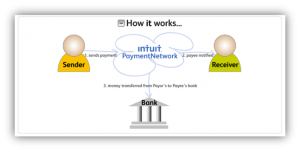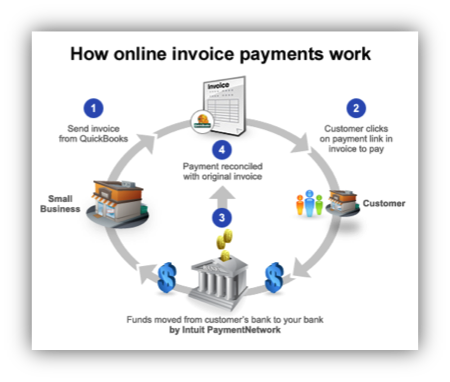Glenbrook Partners Erin McCune and Carol Coye Benson are on a mission to discover if the long-awaited “tipping point” in B2B payments, signalling a world in which electronic payments are the norm, has finally arrived. We’ll be interviewing solution providers over the coming months – let us know if you’d like to talk to us.
Interested in the B2B payments problem? Read why we think the tipping point may be now, and see our target list of company interview targets. And look at “The Problem with B2B” to to learn our thoughts on the myths – and realities – of why progress has been slow.
In our inaugural B2B payments interview, Carol Coye Benson talked with Eric Dunn, senior vice president for payment initiatives at Intuit, and responsible for the Intuit PaymentNetwork – a discreet but very interesting product focused on small business payments.
As all followers of the “long tail” school of product adoption know, small businesses are a (and possibly the) critical factor when you think about really solving the B2B payments problem. Eric has a unique perspective on payments initiatives – both as a long time senior executive at Intuit, and during a recent ten year sojourn as a venture capitalist in Silicon Valley. I was interested to hear how he has brought this perspective to the attractive, but often very frustrating, B2B payments arena.
What is the Intuit PaymentNetwork?
The Intuit PaymentNetwork (IPN) is a new way for small businesses to get paid by other businesses or consumers. (We’re focusing on the B2B piece for this article). A business supplier (or “payee”) can log in to its IPN account and send an invoice. In Intuit’s admirable, no-jargon style, this is called “Request Payment”. The other business (the “customer/payor”) gets an email (“XYZ CO Requests Payment”) and can go online, following a link embedded in the email, and initiate payment. If the customer/payor does not already have an Intuit PaymentNetwork account, they are guided through simple steps to set one up.
That’s the all-online scenario. The killer application of this, however, is the integration into QuickBooks 2011. A supplier using QuickBooks (there are millions of them) can easily send an invoice, in the form of an IPN Payment Request, from within QuickBooks.
This integration alone is probably the single best move we’ve seen towards helping to solve the “long tail” problem.

A Supplier-Side Solution
Many B2B payments solutions start from the perspective of the corporate buyer/payor, not supplier. This has some logic: the typical large-enterprise supplier payment function is a process controlled and carried out by the Accounts Payable (AP) department, which sets off the “check run” or “ACH run” (or, far less commonly, the “card run”) to initiate a batch of payments to suppliers. The problem, of course, with many of these payor-side solutions is that AP departments tend to run out of steam on the whole process of setting up a supplier for electronic payments, once they get beyond that first tranche of big, important suppliers. In other words, they never get to the “long tail”.
 I asked Dunn why they had chosen a supplier-side approach instead. The answer was simple: the motivation to make change, in his opinion, is all on the side of the supplier – the entity that is getting paid. Businesses, as Dunn said, “are a lot more excited about software and technology that helps them get paid” than solutions that focus on paying.
I asked Dunn why they had chosen a supplier-side approach instead. The answer was simple: the motivation to make change, in his opinion, is all on the side of the supplier – the entity that is getting paid. Businesses, as Dunn said, “are a lot more excited about software and technology that helps them get paid” than solutions that focus on paying.
Dunn observed that in the consumer bill payment arena (which he, and Intuit, know a lot about), “biller direct” solutions have been very successful. These solutions bring a consumer to the biller’s website (often from a link in an email), where the consumer initiates a payment. Intuit’s game plan, simply put, is to replicate the success of this model for small business supplier payments.
This makes a lot of sense to us. At Glenbrook, we work closely with eCommerce merchants who are evaluating and implementing various “alternative” payments solutions. It has been our observation that solutions that help merchants sell more trump, hands down, solutions that offer merchants a way to reduce the cost of payments. In the B2B world, this would translate to “a solution that helps suppliers get paid faster will trump a solution that helps a customer automate their processes”.
By the way, an amusing side note is that this version of IPN, at any rate, only allows a customer to pay the whole invoice – frustrating attempts by the customer to short-pay the bill (for reasons legitimate or not) – another feature a supplier will love.
Business Model
IPN has a simple revenue model: 50 cents per transaction, charged to the supplier. When asked, Dunn agreed that there is conceivably some float – but that “we’re not counting on that.” A key part of the business model, of course, is risk management; specifically the risk that the debit transaction (pulling money from the customer/payor) either bounces or is fraudulent. To date, Dunn says, they are very happy with their risk management results. IPN is leveraging Intuit’s considerable expertise in small business credit and risk management, honed through their years as a small business ISO in card acceptance (Intuit Payment Solutions).
Intuit can, of course, manage the relative timing of the two ACH transactions in order to control these risks. They have built a sophisticated model that looks at attributes of both parties, the velocity and amount of the payments, etc. in order to calibrate for risk. Even with the introduction of occasional delays to reduce risk, Dunn observes that IPN has been very successful in delivering payments faster to the supplier/payee than they had been getting paid before – a key element of the value proposition.
One part of IPN’s design helps both Intuit, in terms of risk management, and also the suppliers/payees and customers/payors themselves. When small businesses register for an IPN account, they provide the bank details necessary for the ACH transactions to be effected. But they give this information only to Intuit – not to each other. This helps solve a number of B2B problems. Payors don’t need to worry about exposing their bank accounts to unauthorized debits – Intuit will only debit the account with explicit instructions from the payor, and the payee never even sees the bank data. Payors avoid the problem of having to obtain and safely store payee bank data. Finally, a business can change their bank relationship without having to update records at all of their counterparties.
Road map – Future Plans
I asked Dunn about plans for expansion of IPN. He said that the immediate next step is to connect their customers with other sources of payments that are directed toward small businesses. One source is bank payment networks – for example, payments made by small businesses through their online banking system (another business, by the way, that Intuit is in). Another important source are the payments made to small businesses by large businesses. This is more complex, as tackling this runs right into the AP process issue: obviously, a very large business is unlikely to welcome email “Payment Requests” from a small business as it would be an annoying fragmentation of their standard processes. Dunn thinks that Intuit may approach this from large businesses side – perhaps by taking steps to expose (with Intuit customer consent, of course) Intuit’s network of electronically enabled suppliers. They are talking to NACHA and several industry vendors who are thinking about B2B directory ideas.
By the way, one minor feature of the IPN really caught my eye. IPN allows the supplier/payee to attach a document to the Payment Request. It’s easy to imagine that a small business might have an invoice that has some complicated document behind it, explaining the details of the charge. Rather than trying to insert this information into the invoice (or force it through the ACH system, CTX-style), how simple just to have a PDF attachment – something that any small business would intuitively understand.
Intuit is also working improving the “receiver experience.” They are learning, says Dunn, from larger biller direct companies who have developed best practices to drive adoption of electronic payments. One example is when the customer/payor, who is receiving an IPN Payment Request, does not already have an IPN account. Intuit wants to add a “guest payor model” or a light-weight alternate process. The idea is to simply enable a one-time payment (rather than “sign up for our network”) and then ask the payor if they want to “save this information” for future payments.
Of course, you can’t talk about payments these days without using the “m word.” Intuit has a company-wide “global, mobile, social” strategy. So I asked Dunn whether there was a mobile factor in IPN. He said “mobile plays across everything Intuit does – mobile card acceptance, mobile features on the payor side, etc.” and he explains that they are testing a variety of mobile add-ons to IPN as a part of this process.
Results to Date
I asked Dunn about IPN’s progress. Although they don’t disclose figures, he did say that not only are they happy with the results thus far, but that adoption is increasing strongly month on month. Accountants, he said, are early adopters of IPN – something that has often been true of new QuickBooks functionality.
Dunn anticipates a “multi year process to automate business payments – and one that will require multiple product iterations.” But it is clear that he sees a fundamental change in behavior going on at small businesses.
From my perspective, IPN looks well poised to tap into that behavior change. The focus on suppliers, in particular, is a good. After all, small business owners are always thinking “Show Me The Money” – and IPN is a way for them to ask, politely, that their customers do this.

